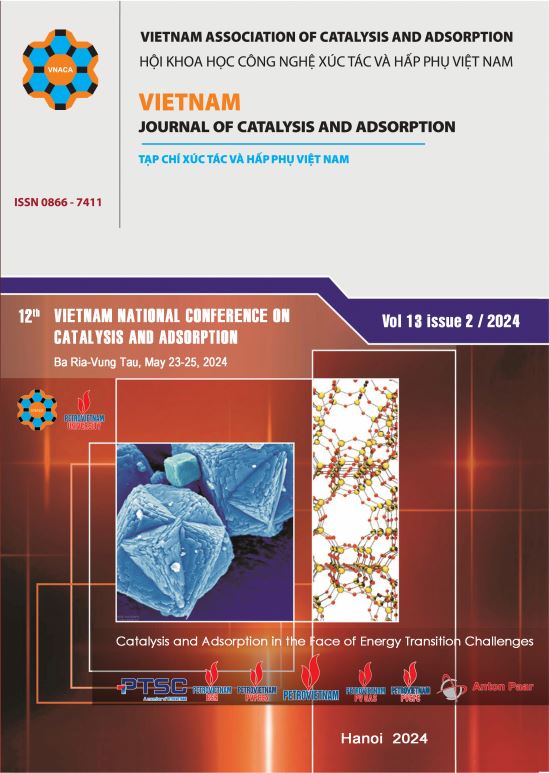Facile fabrication of superhydrophobic ZnO powders coated on polyurethane sponge for effective oil/water separation application
DOI:
https://doi.org/10.62239/jca.2024.043Keywords:
Superhydrophobic, ZnO particles, oil/water separation, superhydrophobicAbstract
Oil spills pose significant challenges to the environment, wildlife, and local economies, thus an effective method for cleaning up an oil spill is urgent. Here, superhydrophobic ZnO powder particles were synthesized using a simple and efficient method and investigated their coating on polyurethane sponge for oil/water separation application. Initially, ZnO particles were prepared through a hydrothermal reaction of Zn(CH3COO)2 and NaOH solution in an autoclave. Subsequently, superhydrophobic ZnO particles were obtained through hydrophobic modification using either stearic acid or 1H, 1H, 2H, 2H-Perfluorooctyltriethoxysilane. The results demonstrate that the ZnO particles exhibited excellent superhydrophobic properties, with contact angle of 153o. After coating superhydrophobic ZnO particles on the polyurethane sponge, the surface became superhydrophobic/oleophilic and could adsorb oil with a capacity measured up to more than 40 times its own weight. Results demonstrate the promising application of superhydrophobic/oleophilic polyurethane sponge for oil/water separation.
Downloads
References
T. Iline-Vul, S. Bretler, S. Cohen, I. Perelshtein, N. Perkas, A. Gedanken, S. Margel, Mater. Today Chem., 21 (2021) 100502. https://doi.org/10.1016/j.mtchem.2021.100520
M. Jin, Q. Xing, and Z. Chen, J. Biomater. Nanobiotechnol., vol. 11, no. 02, pp. 110–149, 2020, https://doi.org/10.4236/jbnb.2020.112008.
L. Gao and T. J. McCarthy, J. Am. Chem. Soc., 128 (2006) 9052–9053. https://doi.org/10.1021/ja062943n
G. Barati Darband, M. Aliofkhazraei, S. Khorsand, S. Sokhanvar, and A. Kaboli, Arab. J. Chem., 13 (2020) 1763–1802. https://doi.org/10.1016/j.arabjc.2018.01.013.
Li Meng, Mingzhong Li, Zhenyu Xu, Aman Lv, Yanwei Jia, Meiwan Chen, Pui-In Mak, Rui P. Martins, Man-Kay Law, Sensors Actuators B Chem., 402 (2004) 135079. https://doi.org/10.1016/j.snb.2023.135079
J. T. Simpson, S. R. Hunter, and T. Aytug, Reports Prog. Phys., 78 (2015) 86501. https://doi.org/10.1088/0034-4885/78/8/086501.
Z. Wang, L. Zhu, H. Liu, and W. Li, J. Pet. Sci. Eng., 112 (2013) 266–272 https://doi.org/10.1016/j.petrol.2013.11.013
Ying Liu, Lian Zhang, Jing Hu, Bo Cheng, Junlong Yao, Yong Huang, Hao Yang, Surf. Coatings Technol., 477 (2023) 130352. https://doi.org/10.1016/j.surfcoat.2023.130352
Er-Chieh Cho, Cai-Wan Chang-Jian, Hsin-Chou Chen, Kao-Shuh Chuang, Jia-Huei Zheng, Yu-Sheng Hsiao, Kuen-Chan Lee, Jen-Hsien Huang, Chem. Eng. J., 314, (2017) 347–357 https://doi.org/10.1016/j.cej.2016.11.145
Liu Huang, Jinlong Song, Yao Lu, Faze Chen, Xin Liu, Zhuji Jin, Danyang Zhao, Claire J. Carmalt, Ivan P. Parkin, Micro Nano Lett., 12 (2017) 76–81. https://doi.org/10.1049/mnl.2016.0576
A. K. Kota, G. Kwon, and A. Tuteja, NPG Asia Mater., 6 (2014) 1–16. https://doi.org/10.1038/am.2014.34
Sanjay S. Latthe, Rajaram S. Sutar, Vishnu S. Kodag, A.K. Bhosale, A. Madhan Kumar, Kishor Kumar Sadasivuni, Ruimin Xing, Shanhu Liu, Prog. Org. Coatings, 128 (2019) 52–58. https://doi.org/10.1016/j.porgcoat.2018.12.008
Dehui Wang, Qiangqiang Sun, Matti J. Hokkanen, Chenglin Zhang, Fan-Yen Lin, Qiang Liu, Shun-Peng Zhu, Tianfeng Zhou, Qing Chang, Bo He, Quan Zhou, Longquan Chen, Zuankai Wang, Robin H. A. Ras & Xu Deng, Nature, 582 (2020) 55–59. https://doi.org/10.1038/s41586-020-2331-8
S. S. Latthe, R. S. Sutar, A. K. Bhosale, K. K. Sadasivuni, and S. Liu, Superhydrophobic surfaces for oil-water separation. Elsevier Inc., 2019.
R. Mardosaitė, A. Jurkevičiū Tė, and S. Račkauskas, Crystal Growth and Design, 21 (2021) 4765–4779. https://doi.org/10.1021/acs.cgd.1c00449
Nguyen Thi Phuong Nhung, Pham Van Tong, Chu Manh Hung, Nguyen Van Duy, Nguyen Viet Chien,
Nguyen Van Vinh, Nguyen Thai Tuyen and Nguyen Duc Hoa, RSC Adv., 6 (2016) 64215–64218. https://doi.org/10.1039/c6ra11531d
A. Moezzi, A. M. McDonagh, and M. B. Cortie, Chemical Engineering Journal, 185–186 (2012) 1–22, https://doi.org/10.1016/j.cej.2012.01.076
S. Nundy, A. Ghosh, and T. K. Mallick, ACS Omega, 5 (2020) 1033–1039. https://doi.org/10.1021/acsomega.9b02758
W. Zhu, Y. Wu, and Y. Zhang, Mater. Res. Express, 6 (2019). https://doi.org/10.1088/2053-1591/ab4ec5
D. Gao and M. Jia, Appl. Surf. Sci., 343 (2015) 172–180. https://doi.org/10.1016/j.apsusc.2015.03.024
Y. Lu, H. Cao, S. Zhang, and X. Zhang, J. Mater. Chem., 21 (2011) 8633–8639. https://doi.org/10.1039/c1jm10957j
B. John, P. R. Rajimol, T. P. D. Rajan, and S. K. Sahoo, Surf. Coatings Technol., 451 (2022) 129036. https://doi.org/10.1016/j.surfcoat.2022.129036
J.Chen, M.Sun, Y.Ni, T.Zhu, J.Huang, X.Li Journal of Ha zardous material, 445, (2022) https://doi.org/10.1016/j.jhazmat.2022.130541
N. Saleema and M. Farzaneh, Appl. Surf. Sci., 254 (2008) 2690–2695. https://doi.org/10.1016/j.apsusc.2007.10.004
V. H. T. Tran and B. K. Lee, Sci. Rep., 7 (2017) 1–12, 2017. https://doi.org/10.1038/s41598-017-17761-9











